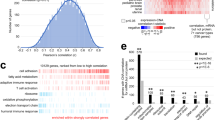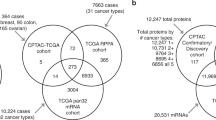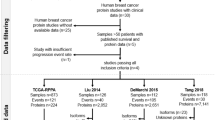Abstract
Proteomic signatures associated with clinical measures of more aggressive cancers could yield molecular clues as to disease drivers. Here, utilizing the Clinical Proteomic Tumor Analysis Consortium (CPTAC) mass-spectrometry-based proteomics datasets, we defined differentially expressed proteins and mRNAs associated with higher grade or higher stage, for each of seven cancer types (breast, colon, lung adenocarcinoma, clear cell renal, ovarian, uterine, and pediatric glioma), representing 794 patients. Widespread differential patterns of total proteins and phosphoproteins involved some common patterns shared between different cancer types. More proteins were associated with higher grade than higher stage. Most proteomic signatures predicted patient survival in independent transcriptomic datasets. The proteomic grade signatures, in particular, involved DNA copy number alterations. Pathways of interest were enriched within the grade-associated proteins across multiple cancer types, including pathways of altered metabolism, Warburg-like effects, and translation factors. Proteomic grade correlations identified protein kinases having functional impact in vitro in uterine endometrial cancer cells, including MAP3K2, MASTL, and TTK. The protein-level grade and stage associations for all proteins profiled—along with corresponding information on phosphorylation, pathways, mRNA expression, and copy alterations—represent a resource for identifying new potential targets. Proteomic analyses are often concordant with corresponding transcriptomic analyses, but with notable exceptions.
This is a preview of subscription content, access via your institution
Access options
Subscribe to this journal
Receive 50 print issues and online access
$259.00 per year
only $5.18 per issue
Buy this article
- Purchase on Springer Link
- Instant access to full article PDF
Prices may be subject to local taxes which are calculated during checkout






Similar content being viewed by others
References
Zhang Y, Kwok-Shing NgP, Kucherlapati M, Chen F, Liu Y, Tsang Y, et al. A pan-cancer proteogenomic atlas of PI3K/AKT/mTOR pathway alterations. Cancer Cell. 2017;31:820–32.
Chen G, Gharib T, Huang C, Taylor J, Misek D, Kardia S, et al. Discordant protein and mRNA expression in lung adenocarcinomas. Mol Cell Proteom. 2002;1:304–13.
Mertins P, Mani D, Ruggles K, Gillette M, Clauser K, Wang P, et al. Proteogenomics connects somatic mutations to signalling in breast cancer. Nature. 2016;534:55–62.
Zhang B, Wang J, Wang X, Zhu J, Liu Q, Shi Z, et al. Proteogenomic characterization of human colon and rectal cancer. Nature. 2014;513:382–387.
Zhang H, Liu T, Zhang Z, Payne S, Zhang B, McDermott J, et al. Integrated proteogenomic characterization of human high-grade serous ovarian. Cancer Cell. 2016;166:755–65.
Dou Y, Kawaler E, Cui Zhou D, Gritsenko M, Huang C, Blumenberg L, et al. Proteogenomic characterization of endometrial carcinoma. Cell. 2020;180:729–48.
Gillette M, Satpathy S, Cao S, Dhanasekaran S, Vasaikar S, Krug K, et al. Proteogenomic characterization reveals therapeutic vulnerabilities in lung adenocarcinoma. Cell. 2020;182:200–25.
Vasaikar S, Huang C, Wang X, Petyuk V, Savage S, Wen B, et al. Proteogenomic analysis of human colon cancer reveals new therapeutic opportunities. Cell. 2019;177:1035–1049. e1019.
The_Cancer_Genome_Atlas_Research_Network. Comprehensive molecular characterization of clear cell renal cell carcinoma. Nature. 2013;499:43–49.
Yuan Y, Van Allen E, Omberg L, Wagle N, Amin-Mansour A, Sokolov A, et al. Assessing the clinical utility of cancer genomic and proteomic data across tumor types. Nat Biotechnol. 2014;32:644–52.
Akbani R, Ng P, Werner H, Shahmoradgoli M, Zhang F, Ju Z. et al. A pan-cancer proteomic perspective on The Cancer Genome Atlas. Nat Commun. 2014;5:3887.
Cancer_Genome_Atlas_Research_Network, Weinstein J, Collisson E, Mills G, Shaw K, Ozenberger B, et al. The cancer genome atlas pan-cancer analysis project. Nat Genet. 2013;45:1113–20.
Chen F, Zhang Y, Gibbons D, Deneen B, Kwiatkowski D, Ittmann M, et al. Pan-cancer molecular classes transcending tumor lineage across 32 cancer types, multiple data platforms, and over 10,000 cases. Clin Cancer Res. 2018;24:2182–93.
Chen F, Chandrashekar D, Varambally S, Creighton C. Pan-cancer molecular subtypes revealed by mass-spectrometry-based proteomic characterization of more than 500 human cancers. Nat Commun. 2019;10:5679.
Rhodes D, Yu J, Shanker K, Deshpande N, Varambally R, Ghosh D, et al. Large-scale meta-analysis of cancer microarray data identifies common transcriptional profiles of neoplastic transformation and progression. Proc Natl Acad Sci USA. 2004;101:9309–14.
Louis D, Perry A, Burger P, Ellison D, Reifenberger G, von Deimling A, et al. International Society Of Neuropathology-Haarlem consensus guidelines for nervous system tumor classification and grading. Brain Pathol. 2014;24:429–35.
Chandrashekar D, Bashel B, Balasubramanya S, Creighton C, Ponce-Rodriguez I, Chakravarthi B, et al. UALCAN: a portal for facilitating tumor subgroup gene expression and survival analyses. Neoplasia. 2017;19:649–58.
Chen F, Zhang Y, Parra E, Rodriguez J, Behrens C, Akbani R, et al. Multiplatform-based molecular subtypes of non-small cell lung cancer. Oncogene. 2016;36:1384–93.
Cancer_Genome_Atlas_Research_Network, Kandoth C, Schultz N, Cherniack A, Akbani R, Liu Y, et al. Integrated genomic characterization of endometrial carcinoma. Nature. 2013;497:67–73.
Bonome T, Lee J, Park D, Radonovich M, Pise-Masison C, Brady J, et al. Expression profiling of serous low malignant potential, low-grade, and high-grade tumors of the ovary. Cancer Res. 2005;65:10602–12.
Crijns A, Fehrmann R, de Jong S, Gerbens F, Meersma G, Klip H, et al. Survival-related profile, pathways, and transcription factors in ovarian cancer. PLoS Med. 2009;6:e24.
Denkert C, Budczies J, Darb-Esfahani S, Györffy B, Sehouli J, Könsgen D, et al. A prognostic gene expression index in ovarian cancer - validation across different independent data sets. J Pathol. 2009;218:273–80.
Dressman H, Berchuck A, Chan G, Zhai J, Bild A, Sayer R, et al. An integrated genomic-based approach to individualized treatment of patients with advanced-stage ovarian cancer. J Clin Oncol. 2007;25:517–25.
Tothill R, Tinker A, George J, Brown R, Fox S, Lade S, et al. Novel molecular subtypes of serous and endometrioid ovarian cancer linked to clinical outcome. Clin Cancer Res. 2008;14:5198–208.
Yoshihara K, Tsunoda T, Shigemizu D, Fujiwara H, Hatae M, Fujiwara H. et al. High-risk ovarian cancer based on 126-gene expression signature is uniquely characterized by downregulation of antigen presentation pathway. Clin Cancer Res. 2012;18:1374–85.
Pereira B, Chin S, Rueda O, Vollan H, Provenzano E, Bardwell H. et al. The somatic mutation profiles of 2,433 breast cancers refines their genomic and transcriptomic landscapes. Nat Commun. 2016;7:11479.
Jorissen R, Gibbs P, Christie M, Prakash S, Lipton L, Desai J, et al. Metastasis-associated gene expression changes predict poor outcomes in patients with dukes stage B and C colorectal cancer. Clin Cancer Res. 2009;15:7642–51.
Zhao H, Ljungberg B, Grankvist K, Rasmuson T, Tibshirani R, Brooks J. Gene expression profiling predicts survival in conventional renal cell carcinoma. PLoS Med. 2006;3:e13.
Slenter D, Kutmon M, Hanspers K, Riutta A, Windsor J, Nunes N, et al. WikiPathways: a multifaceted pathway database bridging metabolomics to other omics research. Nucleic Acids Res. 2018;46:D661–7.
Sridhar R, Hanson-Painton O, Cooper D. Protein kinases as therapeutic targets. Pharm Res. 2000;17:1345–53.
Hanahan D, Weinberg R. The hallmarks of cancer. Cell. 2000;100:57–70.
Creighton C, Beer D, Hanash S. Gene expression patterns define pathways correlated with loss of differentiation in lung adenocarcinomas. FEBS Lett. 2003;540:167–70.
Loi S, Haibe-Kains B, Desmedt C, Lallemand F, Tutt AM, Gillet C, et al. Definition of clinically distinct molecular subtypes in estrogen receptor-positive breast carcinomas through genomic grade. J Clin Oncol. 2007;25:1239–46.
Clark D, Dhanasekaran S, Petralia F, Pan J, Song X, Hu Y, et al. Integrated proteogenomic characterization of clear cell renal cell carcinoma. Cell. 2019;179:964–83.
Chen G, Gharib T, Wang H, Huang C, Kuick R, Thomas D, et al. Protein profiles associated with survival in lung adenocarcinoma. Proc Natl Acad Sci USA. 2003;100:13537–42.
Paik S, Shak S, Tang G, Kim C, Baker J, Cronin M, et al. A multigene assay to predict recurrence of tamoxifen-treated, node-negative breast cancer. N Engl J Med. 2004;351:2817–26.
Ahmad S, St Hilaire V, Dandepally S, Johnson G, Williams A, Scott J. Discovery and characterization of an iminocoumarin scaffold as an inhibitor of MEKK2 (MAP3K2). Biochem Biophys Res Commun. 2018;496:205–11.
Fatima I, Singh A, Dhawan P. MASTL: A novel therapeutic target for Cancer Malignancy. Cancer Med. 2020;9:6322–9.
Libouban M, de Roos J, Uitdehaag J, Willemsen-Seegers N, Mainardi S, Dylus J, et al. Stable aneuploid tumors cells are more sensitive to TTK inhibition than chromosomally unstable cell lines. Oncotarget. 2017;8:38309–25.
Ellis M, Gillette M, Carr S, Paulovich A, Smith R, Rodland K, et al. Connecting genomic alterations to cancer biology with proteomics: the NCI clinical proteomic tumor analysis consortium. Cancer Disco. 2013;3:1108–12.
Edwards N, Oberti M, Thangudu R, Cai S, McGarvey P, Jacob S, et al. The CPTAC data portal: a resource for cancer proteomics research. J Proteome Res. 2015;14:2707–13.
Storey JD, Tibshirani R. Statistical significance for genomewide studies. Proc Natl Acad Sci USA. 2003;100:9440–5.
Ashburner M, Ball CA, Blake JA, Botstein D, Butler H, Cherry JM, et al. Gene ontology: tool for the unification of biology. The Gene Ontology Consortium. Nat Genet. 2000;25:25–29.
Creighton C, Nagaraja A, Hanash S, Matzuk M, Gunaratne P. A bioinformatics tool for linking gene expression profiling results with public databases of microRNA target predictions. RNA. 2008;14:2290–96.
Cancer_Genome_Atlas_Research_Network. Integrated genomic analyses of ovarian carcinoma. Nature. 2011; 474: 609–15.
Creighton C, Hernandez-Herrera A, Jacobsen A, Levine D, Mankoo P, Schultz N, et al. Integrated analyses of microRNAs demonstrate their widespread influence on gene expression in high-grade serous ovarian carcinoma. PLoS ONE. 2012;7:e34546.
Acknowledgements
This research was conducted using data made available by The Clinical Proteomic Tumor Analysis Consortium (CPTAC), The Children’s Brain Tumor Tissue Consortium (CBTTC), and The Cancer Genome Atlas (TCGA) Consortium. This work was supported by National Institutes of Health (NIH) grants P30CA125123 (CJC), P20CA221729 (MMM), R00HD096057 (DM), and a Core Facility Support Award from the Cancer Prevention Research Institute of Texas (RP160805 (MMM)). Diana Monsivais holds a PDEP Award from the Burroughs Wellcome Fund. We thank Jonathan Kurie for critical reading of the manuscript.
Author information
Authors and Affiliations
Contributions
Conceptualization: CJC, DM, YV; Methodology: CJC, FC, YZ, DM, YV; Investigation: CJC, FC, YZ, RPM, MES, DM, YV, JCF, MMM; Formal Analysis: CJC, FC, YZ, DSC, JCF; Data Curation: CJC, SV, DSC; Visualization; CJC; Writing: CJC, DM, YV; Manuscript Review: FC, YZ, DSC, RPM, MES; Supervision: CJC, SV, DM, MMM.
Corresponding authors
Ethics declarations
Conflict of interest
The authors declare no competing interests.
Additional information
Publisher’s note Springer Nature remains neutral with regard to jurisdictional claims in published maps and institutional affiliations.
Rights and permissions
About this article
Cite this article
Monsivais, D., Vasquez, Y.M., Chen, F. et al. Mass-spectrometry-based proteomic correlates of grade and stage reveal pathways and kinases associated with aggressive human cancers. Oncogene 40, 2081–2095 (2021). https://doi.org/10.1038/s41388-021-01681-0
Received:
Revised:
Accepted:
Published:
Issue Date:
DOI: https://doi.org/10.1038/s41388-021-01681-0
This article is cited by
-
Rummagene: massive mining of gene sets from supporting materials of biomedical research publications
Communications Biology (2024)
-
APOB is a potential prognostic biomarker in hepatocellular carcinoma
Discover Oncology (2024)
-
A comprehensive analysis of different types of databases reveals that CDH1 mRNA and E-cadherin protein are not downregulated in most carcinoma tissues and carcinoma cell lines
BMC Cancer (2023)
-
Global impact of somatic structural variation on the cancer proteome
Nature Communications (2023)
-
The N6-methyladenosine modification of circALG1 promotes the metastasis of colorectal cancer mediated by the miR-342-5p/PGF signalling pathway
Molecular Cancer (2022)



